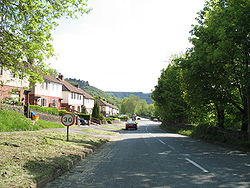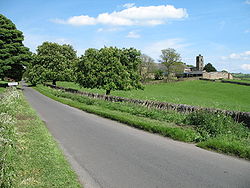
Dethick, Lea and Holloway
Encyclopedia

Civil parish
In England, a civil parish is a territorial designation and, where they are found, the lowest tier of local government below districts and counties...
(and, since 1899, an ecclesiastical parish
Parish
A parish is a territorial unit historically under the pastoral care and clerical jurisdiction of one parish priest, who might be assisted in his pastoral duties by a curate or curates - also priests but not the parish priest - from a more or less central parish church with its associated organization...
), in the Amber Valley
Amber Valley
Amber Valley is a local government district and borough in Derbyshire, England. It takes its name from the River Amber and covers a semi-rural area with a number of small towns formerly based around coal mining and engineering...
borough of the English
England
England is a country that is part of the United Kingdom. It shares land borders with Scotland to the north and Wales to the west; the Irish Sea is to the north west, the Celtic Sea to the south west, with the North Sea to the east and the English Channel to the south separating it from continental...
county of Derbyshire
Derbyshire
Derbyshire is a county in the East Midlands of England. A substantial portion of the Peak District National Park lies within Derbyshire. The northern part of Derbyshire overlaps with the Pennines, a famous chain of hills and mountains. The county contains within its boundary of approx...
.
It is located in central Derbyshire, south east of Matlock, and, as its name suggests, contains the three main settlements – Dethick, Lea and Holloway, as well as the younger village of Lea Bridge.
The area's most notable family is the Nightingales, who spent the summers there. Florence Nightingale
Florence Nightingale
Florence Nightingale OM, RRC was a celebrated English nurse, writer and statistician. She came to prominence for her pioneering work in nursing during the Crimean War, where she tended to wounded soldiers. She was dubbed "The Lady with the Lamp" after her habit of making rounds at night...
stayed at Lea Hurst, and, during the 1880s, nursed her mother and rendered charitable work in the communities of Lea, Holloway and nearby Whatstandwell
Whatstandwell
Whatstandwell is a village on the River Derwent in Derbyshire, England.It is about five miles south of Matlock and about four miles north of Belper...
.
Holloway
The largest of the settlements that compose this civil parish is Holloway, at grid reference SK326562. Holloway has a village shop serving the parish, called 'Mayfield Stores'. Additionally, it is home to a doctor's surgery, a Methodist chapel, the Yew Tree public house (closed in 2008), a village butcher and a small art gallery. The southeastern area of the village is known as 'Leashaw', and the collection of houses scattered among the hills to the east is known as 'Upper Holloway'. Leashaw is the location of Lea Hurst, famous for being built by the Nightingale family as their summer home.A cotton mill was built in 1784 at Holloway by Peter Nightingale (a relative of Florence). He was sued by Richard Arkwright for infringement of patents. Although Arkwright won the case, it attracted the attention of the Lancashire pirate spinners, who in the end succeeded in getting the patents revoked.
The mills were later sold to Thomas Smedley, whose son founded Smedley's Hydro
Smedley's Hydro
Smedley's Hydro is a former hydrotherapy complex in Matlock, Derbyshire.It was built on Matlock Bank by John Smedley in 1853 when it was the largest hydro in the town. Matlock had developed as a spa town after thermal springs were discovered...
in Matlock. The mill was converted to spinning worsted.
Lea

Domesday Book
Domesday Book , now held at The National Archives, Kew, Richmond upon Thames in South West London, is the record of the great survey of much of England and parts of Wales completed in 1086...
when it was spelt Lede and was owned by Ralph fitzHerbert. It is home to a youth activity centre called Lea Green and a public house called the Jug & Glass. There is also a small park, with play equipment for the youth of the parish.
Lea Bridge

Dethick

Dethick Manor
Dethick Manor is a 16th century manor house, situated at Dethick, Amber Valley, Derbyshire, much altered in the 18th century and converted to use as a farmhouse. It is a Grade II* listed building....
; Anthony Babington
Anthony Babington
Anthony Babington was convicted of plotting the assassination of Elizabeth I of England and conspiring with the imprisoned Mary, Queen of Scots...
was executed for his leading role in a plot
Babington Plot
The Babington Plot was a Catholic plot in 1586 to assassinate Queen Elizabeth, a Protestant, and put Mary, Queen of Scots, a Catholic, on the English throne. It led to the execution of Mary. The long-term goal was an invasion by the Spanish forces of King Philip II and the Catholic league in...
to rescue Mary, Queen of Scots, from imprisonment by her cousin Queen Elizabeth I of England
Elizabeth I of England
Elizabeth I was queen regnant of England and Ireland from 17 November 1558 until her death. Sometimes called The Virgin Queen, Gloriana, or Good Queen Bess, Elizabeth was the fifth and last monarch of the Tudor dynasty...
. It will be found at .
Former BBC TV Blue Peter
Blue Peter
Blue Peter is the world's longest-running children's television show, having first aired in 1958. It is shown on CBBC, both in its BBC One programming block and on the CBBC channel. During its history there have been many presenters, often consisting of two women and two men at a time...
presenter Simon Groom
Simon Groom
Simon Groom is a British Producer & Director, best known as a former presenter of Blue Peter.Groom was born in Chesterfield, Derbyshire, and was brought up on a farm in Dethick, which he often visited for Blue Peter reports...
's family had a farm in the village, which he often mentioned on the programme.
Accessibility
Although extremely rural, the parish has remained a popular place to live thanks to its relatively strong accessibility for such a small place. The towns of AlfretonAlfreton
Alfreton is a town and civil parish in Amber Valley, Derbyshire, England, adjoining the Bolsover and North East Derbyshire districts. It was formerly a Norman Manor and later an Urban District. The population of the Alfreton Ward was 7,928 at the 2001 Census...
, Belper
Belper
Belper is a town and civil parish in the local government district of Amber Valley in Derbyshire, England.-Geography:Belper is situated eight miles north of Derby and is centred in the valley of the River Derwent...
, Matlock and Ripley
Ripley, Derbyshire
Ripley is a town in the Amber Valley area of Derbyshire in England.- Earliest history :Not much information is available as to when Ripley was founded, but it existed at the time of the Domesday Book, when it was held by a man called Levenot....
are all just 15 minutes away. Derby
Derby
Derby , is a city and unitary authority in the East Midlands region of England. It lies upon the banks of the River Derwent and is located in the south of the ceremonial county of Derbyshire. In the 2001 census, the population of the city was 233,700, whilst that of the Derby Urban Area was 229,407...
, Chesterfield
Chesterfield
Chesterfield is a market town and a borough of Derbyshire, England. It lies north of Derby, on a confluence of the rivers Rother and Hipper. Its population is 70,260 , making it Derbyshire's largest town...
and Junction 28 of the M1
M1 motorway
The M1 is a north–south motorway in England primarily connecting London to Leeds, where it joins the A1 near Aberford. While the M1 is considered to be the first inter-urban motorway to be completed in the United Kingdom, the first road to be built to motorway standard in the country was the...
are also nearby, with journey times of around 25 minutes.
Facilities
The parish has one pub, a grocery, a butcher, a village hall, a church, a chapel, a Primary school and public toilets. Although the parish is able to receive ADSL Broadband, it does not receive Freeview or channel 5. There is a once-hourly bus route (the 140/141/142) that stops in Lea Bridge, Holloway and Leashaw, connecting the Parish with Matlock, Belper, Ripley and Alfreton.Tourist attractions
The parish is home to three main tourist attractions. Firstly, the Coach House at Lea, which is a collection of farm buildings, converted to house an ice cream parlor, gift shop, restaurant, tea rooms, with a limited amount of guest accommodation. The Coach House was famous for its home-made jersey ice cream, the Shaw family having made the ice cream in a large range of flavours. However, in the last eight years ownership has changed twice, and ice cream available now is no longer homemade.Second, Lea Gardens (also known as Lea Rhododendron Gardens for its extensive collection of this plant) is an open-air landscaped garden, open to the public during the summer months. At its entrance is a small café with indoor & outdoor seating, and a plant shop selling a wide variety of species (only open in summer).
Third, John Smedley's historic clothing mill retains a factory-outlet shop, selling the clothing that it makes at discount prices.
The parish is also very close to, but not linked with:
- Crich Tramway VillageNational Tramway MuseumThe National Tramway Museum, at Crich, in Derbyshire, England, is situated within Crich Tramway Village, a period village containing a pub, cafe, old-style sweetshop, including the tram depots. The village is also home to the Eagle Press, a small museum dedicated to Letterpress Printing including...
- CromfordCromfordCromford is a village, two miles to the south of Matlock in the Derbyshire Dales district in Derbyshire, England. It is principally known for its historical connection with Richard Arkwright, and the Cromford Mill which he built here in 1771...
(Including the Mills, CanalCromford CanalThe Cromford Canal ran 14.5 miles from Cromford to the Erewash Canal in Derbyshire, England with a branch to Pinxton. Built by William Jessop with the assistance of Benjamin Outram, its alignment included four tunnels and 14 locks....
and High Peak TrailCromford and High Peak RailwayThe Cromford and High Peak Railway in Derbyshire, England, was completed in 1831, to carry minerals and goods between the Cromford Canal wharf at High Peak Junction and the Peak Forest Canal at Whaley Bridge -Origins:... - Matlock BathMatlock BathMatlock Bath is a village south of Matlock in Derbyshire, England. Built along the River Derwent, it developed, in the 19th century, as a spa town and still thrives on tourism.-History:In 1698 warm springs were discovered and a Bath House was built...
- Matlock Garden Centre

